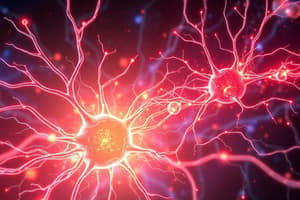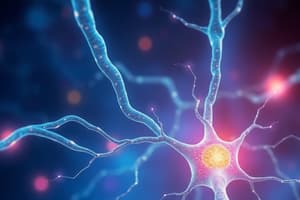Podcast
Questions and Answers
Which of the following is true about the refractory period during an action potential?
Which of the following is true about the refractory period during an action potential?
- It is responsible for the release of neurotransmitters
- It enhances the strength of the action potential
- It limits the frequency of action potential (correct)
- It allows for bidirectional propagation of the action potential
What is the function of neuromodulators?
What is the function of neuromodulators?
- To produce long term intracellular biochemical effects (correct)
- To carry signals across synapses
- To enhance the strength of the action potential
- To limit the frequency of action potential
What is the role of synaptic delay?
What is the role of synaptic delay?
- To excite the postsynaptic neurons
- To inhibit the postsynaptic neurons
- To allow for the release of neurotransmitters
- To assure unidirectional propagation of the action potential (correct)
Flashcards are hidden until you start studying
Study Notes
Neurons, Action Potentials, Synapses, and Neuromodulators: A Comprehensive Overview
- Action potential is the electrochemical changes that occur when an exciteable tissue is stimulated and composed of four principal phases.
- The refractory period assures unidirectional propagation of the action potential and limits the frequency of action potential.
- The junction between two neurons is called a synapse and a neurotransmitter carries a signal across a synapse.
- Some synapses excite the postsynaptic neurons whereas others inhibit it, and the synaptic delay is usually about 0.5 - 1 ms.
- The grand postsynaptic potential (GPSP) depends on the sum of activities in all presynaptic inputs.
- Neuromodulators are chemical messengers that bind to neuronal receptors at non-synaptic sites to produce long term intracellular biochemical effects.
- Neuromodulation is another way to delicately fine-tune the synaptic responses.
- The majority of drugs that influence the nervous system perform their function by altering synaptic mechanisms.
- There are estimated 100 billion neurons in the brain alone, and they are linked to each other through convergence and divergence to form vast and complex nerve pathways.
- Any site along the synaptic pathway is vulnerable to interference, either pharmacological (drug-induced) or pathological (disease-induced).
- A stronger stimulus triggers a greater number of action potential per second to be propagated along the fiber.
- When considering the vast and intricate interconnections possible between these neurons through converging and diverging pathways, we can begin to imagine how complex the wiring mechanism of our nervous system really is.
Studying That Suits You
Use AI to generate personalized quizzes and flashcards to suit your learning preferences.




